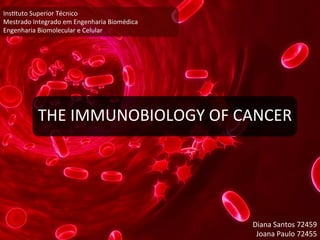
Immunobiology of cancer
- 1. InsCtuto Superior Técnico Mestrado Integrado em Engenharia Biomédica Engenharia Biomolecular e Celular THE IMMUNOBIOLOGY OF CANCER Diana Santos 72459 Joana Paulo 72455
- 2. Outline Cancer and its causes Innate and Adap9ve Immunity Immunosurveillance and Immunoedi9ng Hepatocelular Cancer Immunotherapy Conclusion Bibliography
- 3. Cancer v Cellular proliferaCon in an uncontrolled way; v ReproducCon and no differenCaCon; v Invasion of adjacent Cssues and possible spread in the body – metastasis. Tumors Benign ones Malign ones They are not capable They grow of metastasis: they indefinitely and do not kill the host spread, leading to cells metastasis CANCER
- 4. Cancer Causes External Factors leading to cancer development Carcinogenic UV and X Gene9c Viral Substances Radia9on Factors Infec9ons
- 5. Cancer Causes Tumor suppressing Oncogenes: genes: • Increase on They can induce transcripCon factors apoptosis or delay the Proto-‐Oncogenes: • TranscripCon factors cell cycle, in order to receptor’s acCvaCon have DNA reparaCon They promote the cell • Signal molecules and to prevent growth mutaCon uncontrolled cell They turn the • Increase on the replicaCon replicaCon process expression of anC-‐ WHEN MUTATED possible apoptoCc genes CANCER WHEN MUTATED -‐ Oncogenes
- 6. Cancer Causes Muta9ons Growth Promo9ng Growth Restric9ng
- 7. Innate and AdapCve Immunity
- 8. Immunosurveillance Lewis Thom as and Macfarlane BurneM • Immune System is conCnuously able to supervise the organism and to disCnguish between tumor cells and others; • Tumor cells are immunogenic and disCnct from others (anCgenically); Unless there is a mechanism that allows tumor cells to evade from immune system ac9on, cancers would always be rejected
- 9. Ø An9-‐tumor Immunosurveillance evidence Micro tumors have a high incidence rate than cancers do; Many cancers present in their composiCon immune cells; Tumors are more frequent in immunodeficient paCents; Transplanted paCents, who made immunosupressor treatments present a higher incidence of tumors; Cancer is more likely to appear in advanced ages, when the immune system is lesser effecCve; In some cases, in immunocompetent people, it is possible to occurs a regression of the tumor;
- 10. ImmunoediCng Dunn, G. P., L. J. Old, et al. (2004).
- 11. Ø How can tumor cells avoid the Immunosurveillance? Immunologic tolerance (negaCve selecCon of T cells) Immunosupressor cytokines (IL-‐10, TGF-‐β1, TGF-‐α) Loss/Down-‐regulaCon of MHC-‐I molecules Immunosuppressive cells (T regulatory cells, NKT cells) T and NK cells apoptosis due to FasL high expression levels, by tumor cells
- 12. Ø How can tumor cells avoid the Immunosurveillance? Theresa L, W. (2006)
- 13. Hepatocellular Carcinoma (HCC) • Hepatocellular carcinomas (HCCs) are malignant tumors of liver parenchymal cells • Primary liver cancer is the fihh most common cancer in the world and the third most common cause of cancer mortality Hepatitis B Virus (HBV) probable causes of HCC in at least 80% of cases worldwide
- 14. Ø Immune response against HCC CD4+ CD8+ • Flecken, T., H. Spangenberg, et al. (2011)
- 15. Ø Failure mechanisms of immune responses against HCC Cell Type Mechanism CD4+ T cells DeleCon of helper CD4+ T cell CD8+ T cells ExhausCon of CD8+ T cells UpregulaCon of PD-‐1 Reduced CD28 and CD3 Expression Increase caspase-‐3 acCvity DCs Reduced IL-‐12 producCon Kupffer Cells Increased PD-‐L1 expression MDSCs InducCon of Treg Suppression of NK cell numbers Neutrophils InducCon of angiogenesis NK Cells Reduced NK cell numbers Impaired NK cell Cytotoxicity TAM InducCon of Treg and TC17/Th17 cells TC17/Th17 cells InducCon of angiogenesis by IL-‐17 producCon 15
- 16. How can we take advantage from immunobiologic response? Immunotherapy
- 17. Ø Passive Immunotherapy AdministraCon of monoclonal anCbodies which target either tumour-‐specific or over-‐expressed anCgens. MØ NK Apoptosis Complemented ADCC Conjugated to induction cytotoxicity toxin / isotope
- 18. Ø Ac9ve Immunotherapy • Single peptide Vaccination • Multiple peptides strategies • HSP Complex Cell Cytokines based • Tumour-specific CTL • IL-2 • Tumour-derived APC • IFNs • TNFα • Dendritc Cells
- 19. Ø Effec9ve Therapies Regression of a large liver metastasis from kidney cancer in a pa9ent treated with IL-‐2. Regression is ongoing seven years later Rosenberg (2001)
- 20. Conclusions Immune system plays a surveillance role in controlling the development of cancer Cancer development requires that malign cells escape from the immune system acCon, through a set of mechanisms Tumors like HCC are globally increasing Further research is needed to beoer understand failure mechanisms of immune systems and eventually be able to overcome it. It would be as difficult to reject the right ear and leave the leh ear intact, as it is to immunize against cancer”. W.H.Woglom, Cancer Research (1929)
- 21. Bibliography Conclusions • Visser, K. E., A. Eichten, et al. (2006). "Paradoxical roles of the immune system during cancer development." Nat Rev Cancer 6(1): 24-‐37. • Theresa L, W. (2006). "Immune suppression in cancer: Effects on immune cells, mechanisms and future therapeuCc intervenCon." Seminars in Cancer Biology 16(1): 3-‐15. • Dunn, G. P., L. J. Old, et al. (2004). "The Immunobiology of Cancer Immunosurveillance and ImmunoediCng." Immunity 21(2): 137-‐148. • Rosenberg (2001) Nature, 411;381-‐4 • El-‐Serag HB, Rudolph KL (2007) “Hepatocellular carcinoma: epidemiology and molecular carcinogenesis”. Gastroenterology 132(7):2557–2576. • Spangenberg HC, Thimme R, Blum HE (2009) “Targeted therapy for hepatocellular carcinoma”. Gastroenterology 6 (7):423–432. • Flecken, T., H. Spangenberg, et al. (2011) "Immunobiology of hepatocellular carcinoma." Langenbeck's Archives of Surgery: 1-‐8. • Copland et al (2005) Cancer Immunol. Immunother. 54:297
- 22. Thanks for your aoenCon! Questions
